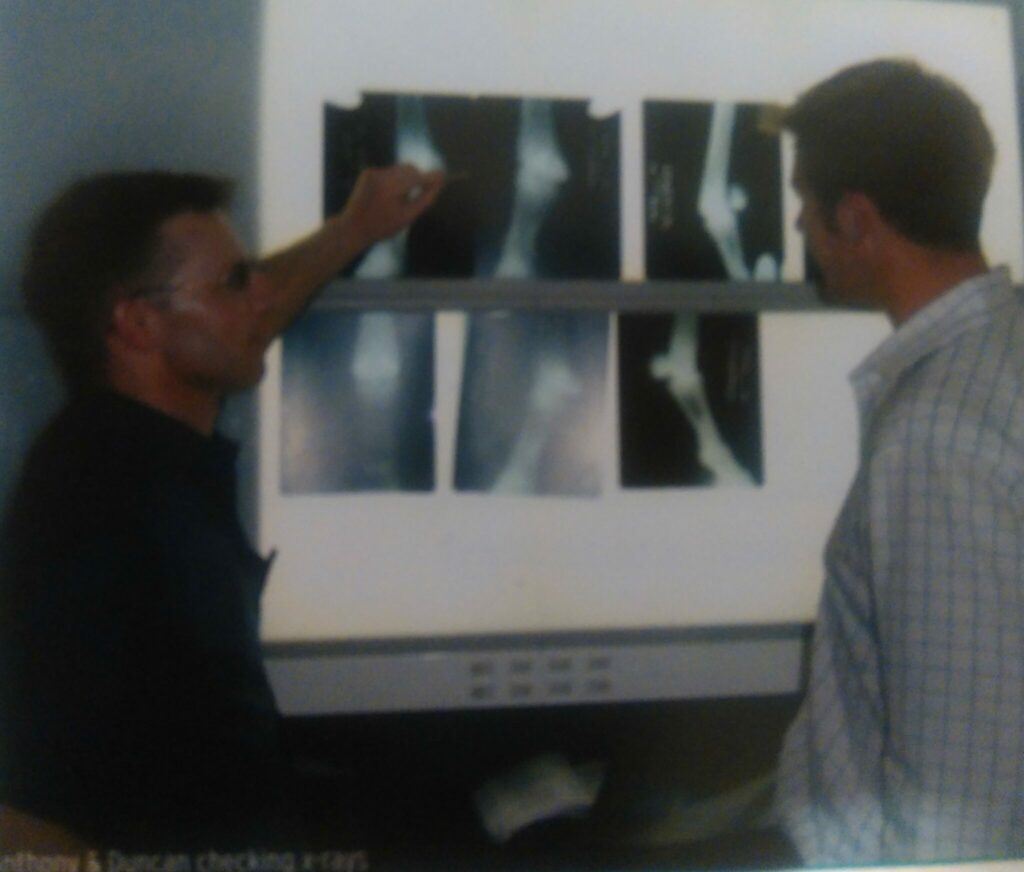It’s sales time again, so we will undoubtedly be forced to deal with that old-but-not-that-old-because it-has-only-appeared-the-last-fifteen-years hoary chestnut: “Why on earth do we have to put up with sales xrays?”
Because of course x-rays can be non-representative and prejudicial. One of the primary examples cited in this debate is Bohemoth, a huge horse with xray abnormalities which prevented most vets from passing him at the sales who nonetheless has had an extremely successful racing career. His owners present him as “exhibit A” in the anti-xray argument, and to be fair who can blame them. The other common argument against xrays comes up when a yearling sells cheaply enough that the vendors have barely made a profit at all and they understandably lament the fact that their tiny (non-existent?) profit has been lightened by $1500+ for xrays.
So it is completely obvious that sales xrays should be done away with. Right??
Well no, not quite. Sales xrays came into real prominence in the 1980s when US yearling prices went through the roof, as any colt with sire potential attracted inflated bids built on the investment portfolios of large conglomerates including huge pension funds. The concept that such investment could be rendered completely wasted based on the fact that a yearling’s knee looked like a pro-hart painting or half their hock was missing suddenly became very important and as a result sales xrays entered the fray.
When I first started scanning sales xrays in Kentucky in 2003 there were still a lot of yearlings presented with extreme radiographic changes such as fractured sesamoids, massive knee chips and golf-ball sized stifle cysts. As buyers started avoiding these major changes, vendors realigned their view of what was reasonable to present at the sales. In a way this should be the end of the story: vendors stopped sending horse for sale with major xray issues, because they knew the horse would not bring any money.
But reality has a way of taking such theoretical neatness and turning it into the proverbial pigs’ breakfast.
For one thing, sales xrays have to continually be presented to show to all that the yearlings which buyers are bidding on are not in fact total disasters. So they are here to stay and it is clearly for good reason.
Some vets themselves possibly contribute to the problem by grading every aspect of yearling xrays from perfection to serious abnormality, with at times scant regard for the crucial question “will it stand up to training or not?” Or as I like to put it, “If you leave the vets in the repository long enough they will start grading the floor tiles”..
To be fair to my veterinary brethren, they are somewhat hamstrung by the fact that they will not be training the horse themselves and so they are forced to make predictions of a horse’s soundness despite not being the person who decides how many times that horse will be galloped at the highest speed on tracks firmer than the Stuart Highway.
And to be even fairer to the vets, the many times their predictions prove correct are very rarely mentioned post-sale. “Horse who vets failed does not make the races” is not a very exciting headline, and as a result few people realise how very often this has come true.
The icing on this whole cake of course becomes the buyers who declare “I never worry about xrays”, in seeming ignorance of the fact that many other people’s efforts in presenting and scanning xrays are usually providing them with the landscape whereby they can follow this approach and not take home horses who will never stand up to training.
And those whose buying policies are aimed at securing bargain buys WITHOUT regard to xrays run a very serious risk that the horses they take home will almost certainly be the horses with serious xray issues, as these are the only ones all the other buyers have left alone to fall into their buying range.
A friend recently sent me xrays from a yearling which a family member had bought but not had vet checked. The horse became lame straight after the sale and on veterinary investigation was found to have irreparable hock deformity – they had been told by their vets that the horse was completely and utterly useless as a racehorse. I was asked for my opinion and sadly I had to just agree with the other vets’ opinion. Perhaps this scenario could more accurately be described as the more accurate “Exhibit A” if we have no xrays?
For myself, as a trainer and a horse vet, sales times is pretty simple, even if extremely busy: I will not buy a yearling whose xrays I have not viewed myself, but when I do view the xrays I can make my own decision on whether I want the horse in the stable, without having to consider someone else taking the horse and putting it under undue pressure.
For the industry? Well despite the times vendors complain or buyers gloat about xray “fails” that go on to be top performers, the sales xrays are here to stay. No matter how imperfect life is with them, yearling sales with absolutely no xrays at all would be a lot worse, to the point of turning a lot of the biggest buyers off completely.
And the vendors would sure as hell not prefer that scenario.

